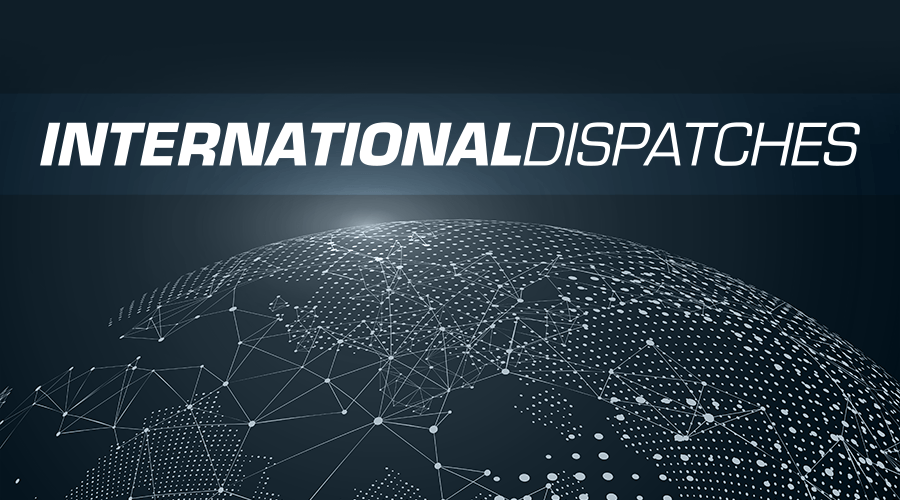Freight transportation reports, projects and other news from outside North America
1/15/2024
Panama drought: Maersk to use rail instead of the canal to move containers across Panama
After evaluating schedule impacts from delays at the Australian East Coast ports, and considering the series of drought-related modifications made to the booking process of the Panama Canal, A.P. Moller-Maersk plans to move containers across Panama via rail rather than the canal, Maersk officials said last week.
"The vessels that utilized the Panama Canal before will now omit the Panama Canal and use a 'land bridge' that utilizes rail to transport cargo across the 80 km of Panama to the other side," Maersk officials said in a Jan. 10 customer advisory. "This creates two separate loops, one Atlantic and one Pacific. Pacific vessels will turn at Balboa, Panama, dropping off cargo heading for Latin America and North America and picking up cargo heading for Australia and New Zealand. Atlantic vessels will turn at Manzanillo, Panama, dropping off cargo heading for Australia and New Zealand and picking up cargo heading for Latin and North America."
Maersk's direct service from the U.S. West Coast to Oceania continues to operate weekly and "can be utilized as an alternative to cargo commonly routed via the U.S. East Coast," company officials added on Jan. 12.
Red Sea scrolling:
• "Oil rose on Friday as an increasing number of oil tankers diverted course from the Red Sea following overnight air and sea strikes by the U.S. and Britain on Houthi targets in Yemen after attacks on shipping by the Iran-backed group." — PFL Petroleum Market Daily Report issued Jan. 12
• Incident involving Maersk Hangzhou prompts Maersk to pause all vessels bound for the Red Sea/Gulf of Aden: On Jan. 2, A.P. Moller –Maersk announced that it would pause all vessels bound for the Red Sea / Gulf of Aden in light of the recent incident involving Maersk Hangzhou and ongoing developments in the area. "The situation is constantly evolving and remains highly volatile, and all available intelligence at hand confirms that the security risk continues to be at a significantly elevated level," Maersk officials said on Jan. 2. "We have therefore decided that all Maersk vessels due to transit the Red Sea / Gulf of Aden will be diverted south around the Cape of Good Hope for the foreseeable future." On Dec. 30, the Maersk Hangzhou was hit by "an unknown object" after passing through the Bab al- Mandab Strait en route from Singapore to Port Suez, Egypt, company officials said on Dec. 31. "After the initial attack, four boats approached Maersk Hangzhou and opened fire in an attempt to board the vessel," Maersk officials said. "Maersk Hangzhou’s security team, along with a helicopter deployed from a nearby navy vessel, successfully thwarted the attempt."
• "... the attacks on vessels in the Red Sea and Suez Canal have forced major shipping companies to look for alternative, more expensive routes — impacting global trade." — Container xChange CEO Christian Roeloffs in the firm's "Where Are All the Containers?" report, issued Jan. 10
• "The recent disruptions at the Red Sea entrance are anticipated to exert additional strain on the container terminals in January 2024. However, the overall impact on the port of Rotterdam's throughput is projected to be minimal. The Port of Rotterdam Authority foresees a decrease of approximately 1.25 million tonnes in the 2023 throughput figures, primarily due to the delays around the year-end transition." — Jan. 3 post on Port of Rotterdam's website
• “The Red Sea is a vital waterway, and a significant amount of global trade flows through it. By forcing nations to go around the Cape of Good Hope, you’re adding weeks and weeks onto voyages, and untold resources and expenses have to be applied in order to do that. So, obviously there’s a concern about the impact on global trade.” — White House spokesman John Kirby on Jan. 3.
Asia: Expect more diversification strategies — Container xChange report
As businesses relocate manufacturing and assembly processes outside China while maintaining ties with Chinese raw materials suppliers, container shipping companies are "ramping up their services" in Asia, "unveiling new routes and expanding existing ones in recent months," according to Container xChange's "Where Are All the Containers?" report, which was issued Jan. 10. One example: Ocean carrier MSC has "enhanced several routes, focusing on strong connections between China and Southeast Asian ports.
Other examples cited in the report:
• CMA CGM unveiled a "fresh direct loop" between western India and China. The weekly service covers Shanghai, Ningbo, Shekou, Singapore, Columbo, Mundra, Nhava Sheva and back to Shanghai.
• During the next three years, AP Moller-Maersk plans to invest more than $500 million expanding its warehouse, air freight and trucking operations in Southeast Asia.
India: DP World to develop multi-purpose deep-draft ports, terminals in Gujarat
DP World signed a series of multiple Memorandums of Understanding (MoU) worth $3 billion with the government of Gujarat, India, covering the development of new ports, terminals and economic zones, DP World officials said on Jan. 10.
Specifically, DP World plans to develop:
• multi-purpose deep-draft ports in South Gujarat and around the western coast of Gujarat toward Kutch;
• special economic zones in Jamnagar and Kutch; and
• Gati Shakti cargo terminals and private freight stations at Dahej, Vadodara, Rajkot, Bedi and Morbi.
DP World has also signed an MoU with Gujarat Maritime Board to jointly identify opportunities to develop additional ports along the coast of Gujarat.